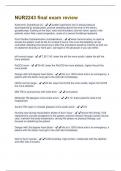NUR2243 final exam review
Autonomic Dysreflexia s/s - ✔️✔️sudden significant rise in blood pressure
accompanied by bradycardia, profuse sweating above the level of the lesion,
goosebumps, flushing of the face, neck and shoulders, blurred vision, spots in the
patients vision field, nasal congestion, onset of a severe throbbing headache
Post Cardiac Catheterization considerations - ✔️✔️when femoral artery is used as
access the patient must lie flat for at least 6 hours, this is so the bleeding can be
controlled. bleeding that would occur after this procedure would be internal so look out
for abdomen bruising or flank pain. call rapid or the physician if you see either.
pH normal range - ✔️✔️7.35-7.45, lower the pH the more acidic, higher the pH the
more alkalotic
PaCO2 norm - ✔️✔️35-45, lower the PaCO2 the more alkalotic, higher the pH the
more acidic
Danger with 3rd degree heart block - ✔️✔️this is a 100% block and is an emergency, a
patient with this block must get to the cath lab immediately.
HCO3 normal range - ✔️✔️22-26, lower the HCO3 the more acidic, higher the HCO3
the more alkalotic
Mild TBI is synonymous with what term - ✔️✔️concussion
Moderate TBI glasgow coma scale score - ✔️✔️9-12, these patients need to be
hospitalized
Severe TBI (open or closed) glasgow coma scale score - ✔️✔️3-8
Nursing care during resuscitation phase of burn injury - ✔️✔️secure the airway, fluid
replacement, provide analgesics to the patient, prevent infection through careful wound
care, maintain the body temperature. during this phase no physical therapy, just
focused on stabilizing the patient
Danger with 3rd degree heart block - ✔️✔️this is a 100% block and is an emergency, a
patient with this block must get to the cath lab immediately.
Diet for burn injuries - ✔️✔️5,000 kcal/day, high protein, collaborate with the dietitian
and offer lots of snacks
, Heat stroke Interventions - ✔️✔️administer oxygen, fluid therapy, lab tests should be
performed for baseline on electrolytes. if they have a high temp do not give tylenol
Communicating with a patient who has expressive aphasia - ✔️✔️this is damage to the
speech center of the brain, use simple phrases and questions, speak clearly without
shouting, ask yes/no questions, use a communication board, do not rush the patient
Neurogenic shock with a spinal cord injury s/s - ✔️✔️decreased O2 sats, bradycardia,
decreased LOC, low urine output, hypotension
Common symptoms after a left sided stroke - ✔️✔️typical to have emotional outbursts
that are not necessarily related to the actual feelings of the patient, the suddenness of
the outbursts suggests that the symptoms are not related to depression
Risk for A-fib patients - ✔️✔️these patients are at higher risk for stroke, so they are put
on anticoagulants like warfarin
If homonymous hemianopsia ( blindness in the same visual field of both eyes), is
affecting the right eye where would you place an object for the patient to see - ✔️✔️on
the left side, left eye
Common symptoms after a right sided stroke - ✔️✔️poor impulse control which leads
to risk for injury when the patient attempts activities like going from a bed to a chair, this
damage can cause left sided hemiparesis
Risk for patients with skull fractures - ✔️✔️these patients are at risk for meningitis,
keep an eye on temperature and any s/s of infection
Nursing consideration when a patient has a head injury - ✔️✔️if there is any clear
drainage from the nose it must be tested for glucose and the positive halo sign, this is
indicative of CSF
Patient positioning for brain swelling/cerebral edema - ✔️✔️HOB upright 30 degrees,
because this patient has increased ICP and the increased pressure can cause the brain
to herniate and come out any weak points in the skull
Planning care for patients with increased ICP - ✔️✔️do not cluster care
more interventions for heat stroke - ✔️✔️cooling blanket, ice, fans, put wet clothing on
the patient with the fans going
Ataxia - ✔️✔️is gait issues, help this patient by using a gait belt




